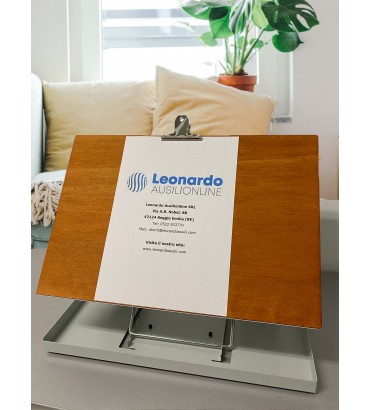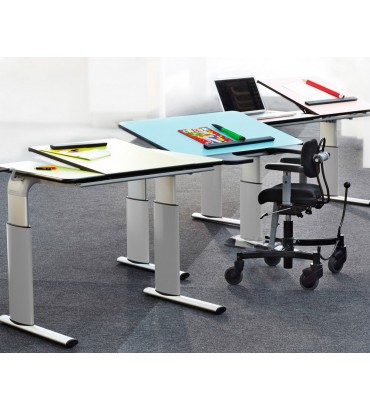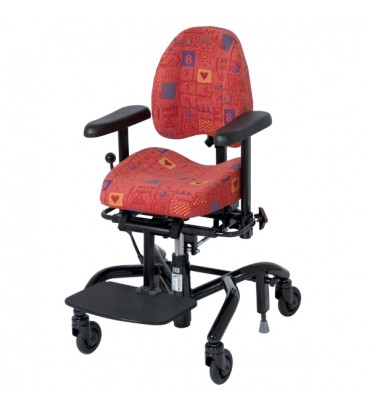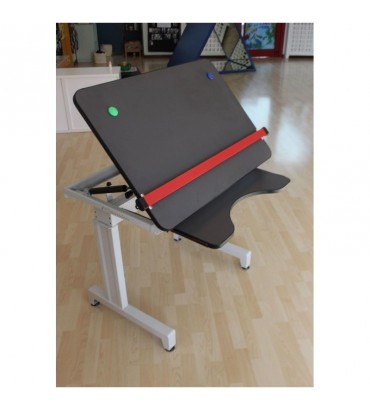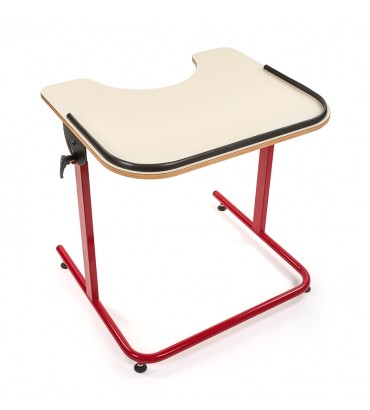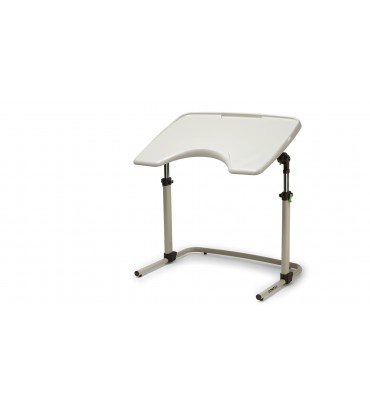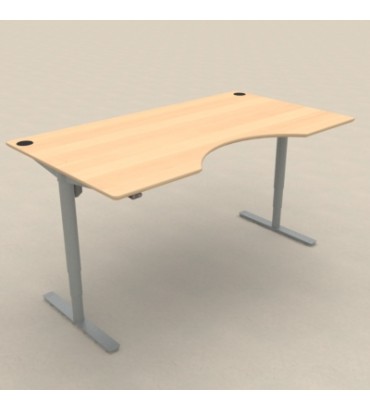.
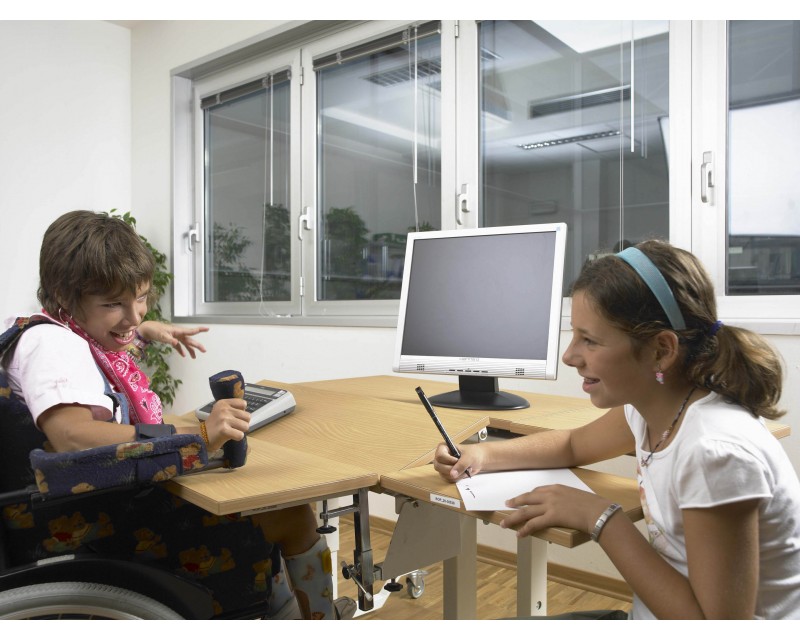
L'ASSETTO OTTIMALE DELLA POSTAZIONE DI LAVORO: a casa, al lavoro, a scuola e nelle attività del...
del: 10/10/2005
Il tavolo e la seduta, gli strumenti, i materiali e l'illuminazione determinano le caratteristiche della postazione di lavoro per le attività a casa, in ufficio, a scuola ed in relazione a quelle di svago o di riabilitazione.
In Danimarca l'assetto della postazione di lavoro è basato su principi generali e know-how di tipo ergonomico e biomeccanico fondati sugli standard ergonomici europei, fatti propri dalla legislazione danese riguardante il luogo di lavoro.
Esiste sempre una postazione migliore
Possibilità di spostamento e di variazione della posizione sono gli aspetti principali legati al buon assetto della postazione di lavoro. Queste caratteristiche sono necessarie per evitare disturbi professionali legati alla scorretta postura e sono i requisiti fondamentali di buone postazioni di lavoro. Il movimento e la variazione sono particolarmente importanti per gli utenti con disabilità funzionali; chi lavora dalla sedia a rotelle ha spesso problemi nei movimenti.
Una strumentazione flessibile offre possibilità di variazione e spostamento
Possibilità di variare posizione e struttura sono necessari per una postazione flessibile.
Questa può essere ottenuta utilizzando sedie regolabili, strumenti adattabili e tavoli flessibili che si possano regolare.
Per persone con disabilità funzionali, che incontrano difficoltà nel cambiare la posizione di lavoro, l'equipaggiamento della stessa può contribuire a facilitare l'attività, l'indipendenza e la variazione perché consente diverse postazioni a seconda dell'attività da svolgere.
Postazione flessibile = postazione che:
- si adatta alle abilità funzionali dell'utilizzatore,
- può essere regolata per soddisfare i bisogni di diversi utilizzatori,
- può essere regolata per soddisfare le esigenze di un aiutante, un terapista, ecc. che lavora insieme alla persona disabile,
- può essere regolata a seconda dell'attività che viene svolta,
- consente diverse variazioni offrendo spazio per utilizzatore e materiali e rende possibili stare seduti, in piedi e di muoversi.
Una buona seduta
Una buona sedia di lavoro deve essere regolabile in altezza, nella seduta e nello schienale.
Gran parte delle sedie da lavoro e delle sedie da ufficio che si trovano sul mercato fanno fronte a queste richieste. Per utenti con disabilità funzionale una buona seduta è ancor più importante poichè spesso rimangono seduti anche durante attività che da altri vengono svolte in piedi.
Chi utilizza la sedia a rotelle normalmente la utilizza anche come seduta da lavoro, il che richiede che il tavolo sia ancor più flessibile, in quanto da questa flessibilità dipende la possibilità di cambiare le postazioni di lavoro.
Un buon tavolo da lavoro
La possibilità di movimento e variazione dipendono strettamente dalla flessibilità del tavolo. La sua altezza, la forma del piano d'appoggio, il design del telaio e gli accessori offrono molteplici possibilità: scegliendo un tavolo da lavoro realmente flessibile si avrà una buona postazione per stare seduti o in piedi, in cucina, nel bagno, in ufficio, a scuola e durante le attività di tempo libero.
- Il tavolo deve essere facilmente regolabile in altezza tramite una manovella, con meccanismo idraulico o elettrico, a seconda delle esigenze.
- L'altezza del tavolo deve essere regolabile tra 60 e 75 cm per le attività da seduti (45-50 cm per i bambini), e tra 85 e 130 cm per le attività da svolgere in piedi. Maggiore è la possibilità di regolazione in altezza, migliore è la possibilità di adattamento in base alle attività da svolgere. Ad esempio, l'altezza del tavolo varia a seconda che si stia lavorando con oggetti piccoli o con oggetti pesanti, con un computer o con carta e penna.
- Sotto il tavolo non devono essere presenti elementi che tolgano spazio alle gambe o non consentano il movimento, anche da seduti (ad esempio in una sedia a rotelle con supporti ad angolo per le gambe).
- Sarebbe bene scegliere un tavolo con le ruote, soprattutto se il tavolo deve essere spostato, ad esempio dalla postazione di lavoro a quella della terapia o nelle attività di casa. Le rotelle devono essere fornite di freni.
- Il tavolo deve essere stabile affinché possa essere utilizzato come appoggio per alzarsi e sedersi. Questo risulta particolarmente importante per le persone con problemi di equilibrio o nel cammino.
- Il ripiano del tavolo non dovrebbe avere fasce o bordi per evitare problemi per gli utenti con sedia a rotelle, che incontrano spesso difficoltà nel far scorrere sotto il tavolo la sedia ed i suoi accessori.
- Può essere utile un piano inclinabile: consente la miglior posizione della schiena e del collo, una minore distanza visiva e può essere conveniente per persone con mobilità ridotta di braccia e schiena.
- La dimensione e la forma del ripiano del tavolo devono essere adatti all'attività da svolgere. Ci deve essere sufficiente spazio per i materiali e per gli strumenti (per esempio video, tastiera, carta, supporto per la scrittura) e per mettere le cose da parte. Un ripiano del tavolo che è troppo piccolo non offre possibilità di variazione - e un ripiano del tavolo che è troppo grande può rendere difficile raggiungere gli oggetti sul tavolo a chi presenta mobilità ridotta nelle braccia e nella schiena. Un piano con incavo nella parte anteriore può essere consigliabile per coloro che necessitano di supporto per gli arti superiori, ma può essere uno svantaggio se si desidera muoversi lungo il tavolo per variare la posizione di lavoro.
Esempi di buone postazioni di lavoro
Il tavolo da nursing
Un tavolo regolabile in altezza offre buone postazioni per personale e genitori, dal momento che il tavolo può essere regolato a seconda dell'altezza di chi lo utilizza.
Scegliendo un tavolo che si può abbassare fino a 35 cm, il bambino potrà salire da solo sul tavolo e non sarà necessario sollevarlo.
Il tavolo da cucina
Il tavolo da cucina con altezza regolabile consente sia di stare seduti, sia di lavorare in piedi al tavolo e fornisce l'altezza ideale per adulti e bambini.
L'altezza del tavolo può anche essere regolata per soddisfare l'attività specifica, ad esempio impastare la pasta o fare panini, ecc.
Il piano d'appoggio del bagno
Una bacinella inserita in un ripiano del tavolo è una buona idea, per poter avere gli oggetti necessari vicino al lavabo. Inoltre, il ripiano del tavolo può fornire il supporto braccia a mani. Un lavabo regolabile in altezza può essere utilizzato dalla posizione seduta o eretta, da adulti e da bambini.
La scrivania per lo studio
Una scrivania regolabile segue la variazione in altezza dei bambini sia quando sono seduti, sia quando lavorano in piedi. Questo è ideale per tutti i bambini che possono variare la loro postura di lavoro durante il giorno. Un piano inclinabile consente una miglior posizione durante la lettura.
La scrivania per l'ufficio
La variazione si ottiene cambiando la postura di lavoro durante il giorno. Molte attività possono essere effettuate anche stando in piedi - per esempio lavoro al computer, conversazioni telefoniche, lettura o attività di riunione. Un tavolo sitting/standing offre molte possibilità di variazione - ma richiede naturalmente di abbandonare l'abitudine alla posizione seduta.
Il tavolo per la terapia
Un buon tavolo per le attività riabilitative dipende dalla posizione assunta durante il lavoro.
Nelle situazioni di addestramento, quando l'utente ed il terapista stanno seduti esercitando braccia, mani, collo, schiena o le funzioni cognitive, il tavolo da lavoro può essere di supporto ed incoraggiare l'attività offrendo appoggio e sostegno.
Karen Lyng, terapista occupazionale
Karen Lyng ha sempre lavorato nell'ambito dell'Assistive Technology all'interno di servizi pubblici e presso aziende produttrici di ausili per disabili.
Si è occupata di ausili tecnologici sia nella fase di produzione (test, valutazione e sviluppo del prodotto), sia nell fase di vendita, formazione all'utilizzo, esportazione dei prodotti relativi alla tecnologia assistiva.
Si è anche occupata dello studio delle postazioni nei diversi ambienti di vita: a casa e nel luogo di lavoro.
Ella ha inoltre scritto libri, guide e materiali informativi sui dispositivi tecnologici in relazione ai diversi tipi di disabilità.
Karen Lyng è una terapista occupazionale. Ha lavorato presso i servizi pubblici danesi, in particolare per il Centro Danese di Tecnologia Assistiva (Danish Centre for Assistive Technology ) e per il College di Terapia Occupazionale a Copenhagen (Copenhagen College for Occupational Therapy). Ha poi collaborato con diverse aziende del settore, recentemente con Ropox che produce tavoli ergonomici. Attualmente lavora come supervisore nel gruppo di riabilitazione danese, associazione di aziende e fornitori di prodotti per utenti disabili.
(traduzione a cura di Cristina Sassi c.sassi@leonardoausili.com)
Di seguito la versione originale dell'articolo
The Best Workplace Layout:
at home, in the office, at school and for leisure-time activities
Chair and table, tools and implements, materials and lighting provide the physical layout of the workplace, for activities at home, in the office, at school and in connection with leisure-time or training activities.
In Denmark we base the layout of the workplace on general principles and know-how concerning ergonomics and biomechanics against the background of European ergonomic standards incorporated in Danish legislation and directions concerning the working environment.
There is always a better working posture
Movement and variation are leading principles in connection with the good workplace layout.
Movement and variation are necessary in order to avoid work-related injury and are the prerequisites of good, dynamic working postures.
Movement and variation are particularly important for functionally disabled people and wheelchair users as their natural movements are often hampered.
Flexible equipment offers movement and variation
Movement and variation call for flexible equipment. This may be obtained by using adjustable chairs, adjustable equipment and adjustable and flexible tables.
For people with functional disablement, who have difficulties in varying their working postures, the equipment may contribute to encouraging activity, independence and variation because it offers the possibility of various working postures.
Flexible equipment = equipment, which
- suits the user and his/her functional level
- may be adjusted to suit the needs of different users ,
- may be adjusted to suit a helper, therapist etc. working together or simultaneously with the user
- may be adjusted to suit the work or activity in question
- offers the possibility of variation by providing space for the user and materials and makes it possible to stand/sit in various postures and to move.
The good work chair
A good work chair must be adjustable in height, in the seat and in the back. Most good work chairs and office chairs on the market meet these requirements.
For people with functional disablement a good work chair is even more important as they often sit down for a longer period of time in situations, when other people usually stand. Normally the wheelchair users use their wheelchair as a work chair, which requires more from the worktable as the flexibility of the table enables the users to vary their working postures.
The good work table
The possibility of movement and variation highly depends on the flexibility of the table. The table height, the shape of the tabletop, the design of the frame and the accessories offer many possibilities, and if you choose a very flexible table you will get a good workplace for seated and standing work in the kitchen, in the bathroom, in the office, at school and for leisure-time activities.
- The table must be easily adjustable in height by means of a crank handle, hydraulically or electrically, as required.
- The table height must be adjustable between 60 and 75 cm to suit seated activities (down to 45-50 cm for children), and between 85 and 130 cm for ordinary standing activities. The higher the flexibility in height, the better the possibility of individual adjustment and variation depending on the activities in question. For instance, the table height varies depending on whether you are working with small objects or with heavy objects, whether you are working with a computer or with paper and pencil.
- There must be no inconvenient braces under the tabletop in order to provide space for the legs and for movement - also when you sit down, perhaps in a wheelchair with angular leg supports.
- It may be a good idea to choose a table with wheels if the table must be moved around, e.g. at a working place, in training situations or at home. The wheels must be provided with brakes.
- The table must be stable and stand firm so that it may be used as a support to get up and sit down. This is particularly important for people with reduced balance as well as walking-impaired persons.
- The tabletop should have no fascias or edges in order to avoid problems for wheelchair users, who often experience difficulties in getting under the table with the wheelchair and accessories.
- A tiltable tabletop may be useful. It offers better positions of back and neck, shorter visual distance and may be advantageous for people with reduced mobility in arms and back
- The size and shape of the tabletop must suit the activity in question. There must be room for materials and instruments (e.g. monitor, keyboard, paper, manuscript holder) and for putting things aside. A tabletop that is too small does not offer variation - and a tabletop that is too big may make it difficult for people with reduced mobility in their arms and back to get at the objects on the table. A tabletop with cutout in the front may be advisable for those, who need support of hands and arms, but may be a disadvantage if you want to move along the table to vary the working posture.
Examples of good workplace layout
The nursing table
A height-adjustable nursing table offers good working postures for personnel and parents, as the table may be adjusted to a suitable height. If you choose a nursing table adjustable down to a height of 35 cm, the child may be able to climb on to the table, whereby lifting will be avoided.
The kitchen table
A height-adjustable kitchen table offers the possibility of standing and sitting at the table and provides the ideal working height for children and adults. The height of the kitchen table may also be adjusted to suit the specific activity, e.g. dough kneading, sandwich making etc.
The bathroom vanity unit
A washbasin built into a tabletop is a good idea, as you may have your things lying close to the washbasin. Also, the tabletop may provide support for arms and hands. A height-adjustable washbasin may be used by seated and standing persons and by children and adults.
The educational desk
A height-adjustable desk offering adjustment to suit the height of the individual child as well as seated and standing work is ideal for all children as they may vary their working posture during the day. A tiltable tabletop offers improved working posture when reading.
The office desk
Variation is obtained by changing the working posture during the day. Many activities may be carried out in standing position - e.g. computer work, telephone conversations, reading or meeting activities. A sitting/standing table offers many possibilities of variation - but naturally it requires routine and motivation to get up from the seated position.
The training table
A good training result will often depend on the working posture. In training situations, when the user and the therapist sit down training arms, hands, neck, back or cognitive functions, the worktable may encourage training and activity through the support of arms and hands as well as shorter reach.
Karen Lyng, Occupational Therapist, Copenhagen
Karen Lyng has worked with assistive technology for disabled people all her working life, within the public sector and in production facilities.
She has been engaged in the provision of equipment for disabled people, testing and quality appraisal of products, standardization, product development, sales, marketing, consultancy, training, exhibitions and export of assistive technology products.
In addition she has been occupied with flexible equipment in relation to the working environment, e.g. in connection with handling of persons and workplace layouts at work and at home.
She has also written books, guidelines and leaflets about the use of assistive devices for handling persons.
Karen Lyng has a diploma as Occupational Therapist. She has been employed with the local authority in Copenhagen, with the Danish Centre for Assistive Technology, with the Copenhagen College for Occupational Therapy and with different manufacturers of assistive equipment, recently with Ropox, a Danish manufacturer of height-adjustable equipment. Today she works as chief consultant in the Danish Rehabilitation Group, the trade association of manufacturers and suppliers of assistive technology products and services for disabled people.

